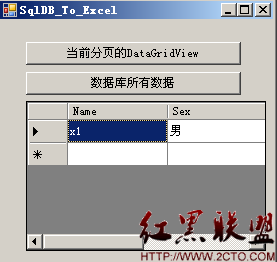在日常的項目中,Excel,Word,txt等格式的數據導入到數據庫中是很常見的,我在這裡做一下總結
這裡將分為Asp.net導入Sql Server,Oracle數據庫和WinForm導入Sql Server,Oracle數據庫。
這裡將的數據庫數據庫導入導出,其實對Sql Server 和Oracle都是通用的
如果使用ADO.Net連接Oracle數據庫,需要在引用裡添加“System.Data.OracleClient ”,其他方面與連接Sql Server數據庫是一樣的
SqlConnection cn = new SqlConnection();
OracleConnection oraleCn = new OracleConnection();
如果使用諸如Ibatis等持久層框架的話,唯一的區別就是在數據庫連接語句上的差別而已。下面是兩個例子
Oracle:Data Source=192.168.0.11/Contact;User ID=system;Password=ss;Unicode=True
Sql Server:Data Source=Contact;Server=localhost;uid=sa;pwd=ss
1,數據庫導出到Excel
先看界面

然後是代碼
using System;
using System.Collections.Generic;
using System.ComponentModel;
using System.Data;
using System.Drawing;
using System.Linq;
using System.Text;
using System.Windows.Forms;
using System.Diagnostics;
using Microsoft.Office.Interop.Excel;
using System.Reflection;
using System.IO;
using System.Data.SqlClient;
using System.Data.OracleClient;
namespace SqlServer__Excel
{
public partial class SqlDB_To_Excel : Form
{
public SqlDB_To_Excel()
{
InitializeComponent();
}
private Microsoft.Office.Interop.Excel.Application myExcel = null;
private void button1_Click(object sender, EventArgs e)
{
print(dataGridView1);
}
public void print(DataGridView dataGridView1)
{
//導出到execl
try
{
SaveFileDialog saveFileDialog = new SaveFileDialog();
saveFileDialog.Filter = "導出Excel (*.xls)|*.xls";
saveFileDialog.FilterIndex = 0;
saveFileDialog.RestoreDirectory = true;
saveFileDialog.CreatePrompt = true;
saveFileDialog.Title = "導出文件保存路徑";
saveFileDialog.ShowDialog();
string strName = saveFileDialog.FileName;
if(strName.Length != 0)
{
//沒有數據的話就不往下執行
if(dataGridView1.Rows.Count == 0)
return;
// toolStripProgressBar1.Visible = true;
System.Reflection.Missing miss = System.Reflection.Missing.Value;
//實例化一個Excel.Application對象
Microsoft.Office.Interop.Excel.Application excel = new Microsoft.Office.Interop.Excel.Application();
excel.Application.Workbooks.Add(true);
excel.Visible = false;//若是true,則在導出的時候會顯示EXcel界面。
if(excel == null)
{
MessageBox.Show("EXCEL無法啟動!", "錯誤", MessageBoxButtons.OK, MessageBoxIcon.Error);
return;
}
Microsoft.Office.Interop.Excel.Workbooks books = (Microsoft.Office.Interop.Excel.Workbooks)excel.Workbooks;
Microsoft.Office.Interop.Excel.Workbook book = (Microsoft.Office.Interop.Excel.Workbook)(books.Add(miss));
Microsoft.Office.Interop.Excel.Worksheet sheet = (Microsoft.Office.Interop.Excel.Worksheet)book.ActiveSheet;
sheet.Name = "test";
int m = 0, n = 0;
//生成Excel中列頭名稱
for(int i = 0; i < dataGridView1.Columns.Count; i++)
{
excel.Cells[1, i + 1] = dataGridView1.Columns[i].HeaderText;//輸出DataGridView列頭名
}
//把DataGridView當前頁的數據保存在Excel中
for(int i = 0; i < dataGridView1.Rows.Count - 1; i++)
{
for(int j = 0; j < dataGridView1.Columns.Count; j++)
{
if(dataGridView1[j, i].ValueType == typeof(string))
{
excel.Cells[i + 2, j + 1] = "'" + dataGridView1[j, i].Value.ToString();
}
else
{
excel.Cells[i + 2, j + 1] = dataGridView1[j, i].Value.ToString();
}
}
}
sheet.SaveAs(strName, miss, miss, miss, miss, miss, Microsoft.Office.Interop.Excel.XlSaveAsAccessMode.xlNoChange, miss, miss, miss);
book.Close(false, miss, miss);
books.Close();
excel.Quit();
System.Runtime.InteropServices.Marshal.ReleaseComObject(sheet);
System.Runtime.InteropServices.Marshal.ReleaseComObject(book);
System.Runtime.InteropServices.Marshal.ReleaseComObject(books);
System.Runtime.InteropServices.Marshal.ReleaseComObject(excel);
GC.Collect();
MessageBox.Show("數據已經成功導出!", "提示", MessageBoxButtons.OK, MessageBoxIcon.Information);
// toolStripProgressBar1.Value = 0;
System.Diagnostics.Process.Start(strName);
}
}
catch(Exception ex)
{
MessageBox.Show(ex.Message, "錯誤提示");
}
}
public void printAll(System.Data.DataTable dt)
{
//導出到execl
try
{
SaveFileDialog saveFileDialog = new SaveFileDialog();
saveFileDialog.Filter = "導出Excel (*.xls)|*.xls";
saveFileDialog.FilterIndex = 0;
saveFileDialog.RestoreDirectory = true;
saveFileDialog.CreatePrompt = true;
saveFileDialog.Title = "導出文件保存路徑";
saveFileDialog.ShowDialog();
string strName = saveFileDialog.FileName;
if(strName.Length != 0)
{
//沒有數據的話就不往下執行
if(dt.Rows.Count == 0)
return;
// toolStripProgressBar1.Visible = true;
System.Reflection.Missing miss = System.Reflection.Missing.Value;
//實例化一個Excel.Application對象
Microsoft.Office.Interop.Excel.Application excel = new Microsoft.Office.Interop.Excel.Application();
excel.Application.Workbooks.Add(true);
excel.Visible = false;//若是true,則在導出的時候會顯示EXcel界面。
if(excel == null)
{
MessageBox.Show("EXCEL無法啟動!", "錯誤", MessageBoxButtons.OK, MessageBoxIcon.Error);
return;
}
Microsoft.Office.Interop.Excel.Workbooks books = (Microsoft.Office.Interop.Excel.Workbooks)excel.Workbooks;
Microsoft.Office.Interop.Excel.Workbook book = (Microsoft.Office.Interop.Excel.Workbook)(books.Add(miss));
Microsoft.Office.Interop.Excel.Worksheet sheet = (Microsoft.Office.Interop.Excel.Worksheet)book.ActiveSheet;
sheet.Name = "test";
int m = 0, n = 0;
//生成Excel中列頭名稱
for(int i = 0; i < dt.Columns.Count; i++)
{
excel.Cells[1, i + 1] = dataGridView1.Columns[i].HeaderText;//輸出DataGridView列頭名
}
//把DataGridView當前頁的數據保存在Excel中
if(dt.Rows.Count > 0)
{
for(int i = 0; i < dt.Rows.Count; i++)//控制Excel中行,上下的距離,就是可以到Excel最下的行數,比數據長了報錯,比數據短了會顯示不完
{
for(int j = 0; j < dt.Columns.Count; j++)//控制Excel中列,左右的距離,就是可以到Excel最右的列數,比數據長了報錯,比數據短了會顯示不完
{
string str = dt.Rows[i][j].ToString();
excel.Cells[i + 2, j + 1] = "'" + str;//i控制行,從Excel中第2行開始輸出第一行數據,j控制列,從Excel中第1列輸出第1列數據,"'" +是以string形式保存,所以遇到數字不會轉成16進制
}
}
}
sheet.SaveAs(strName, miss, miss, miss, miss, miss, Microsoft.Office.Interop.Excel.XlSaveAsAccessMode.xlNoChange, miss, miss, miss);
book.Close(false, miss, miss);
books.Close();
excel.Quit();
System.Runtime.InteropServices.Marshal.ReleaseComObject(sheet);
System.Runtime.InteropServices.Marshal.ReleaseComObject(book);
System.Runtime.InteropServices.Marshal.ReleaseComObject(books);
System.Runtime.InteropServices.Marshal.ReleaseComObject(excel);
GC.Collect();
MessageBox.Show("數據已經成功導出!", "提示", MessageBoxButtons.OK, MessageBoxIcon.Information);
// toolStripProgressBar1.Value = 0;
System.Diagnostics.Process.Start(strName);
}
}
catch(Exception ex)
{
MessageBox.Show(ex.Message, "錯誤提示");
}
}
private void SqlDB_To_Excel_Load(object sender, EventArgs e)
{
dataGridView1.DataSource = GetDataTableFromSqlServer();
}
private void button2_Click(object sender, EventArgs e)
{
printAll(GetDataTableFromSqlServer());
}
private System.Data.DataTable GetDataTableFromSqlServer()
{
string sqlconn = "database=database1;server=localhost;uid=sa;pwd=sa";
SqlConnection cn = new SqlConnection(sqlconn);
string cmdText = "select * from users";
SqlDataAdapter da = new SqlDataAdapter(cmdText, cn);
DataSet ds = new DataSet();
da.Fill(ds, "table1");
return ds.Tables[0];
}
private System.Data.DataTable GetDataTableFromOracle()
{
string oracleconn = "Data Source=192.168.2.105/Database1;User ID=system;Password=ss;Unicode=True";
OracleConnection cn = new OracleConnection(oracleconn);
string cmdText = "select * from users";
OracleDataAdapter da = new OracleDataAdapter(cmdText, cn);
DataSet ds = new DataSet();
da.Fill(ds, "table1");
return ds.Tables[0];
}
}
}
結果:

代碼的思想就是將數據從數據庫中讀出到DataTable或者DataGridView中,然後遍歷他們的每一個單元格的值,給Excel對應的單元格賦值。
使用DataTable作為遍歷的對象,是為了去除分頁的困擾。
看到這裡,如果換一個List<T>對象集合,也應該能導出到數據庫中了。
2,Excel數據導入到數據庫
在WinForm中Excel導入到數據庫中和在WebForm中的導入過程是一樣的。可參見前面的內容。
這個系列的博客到此結束!